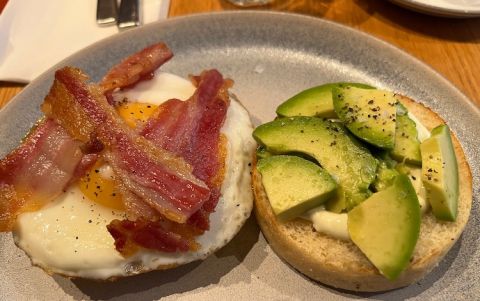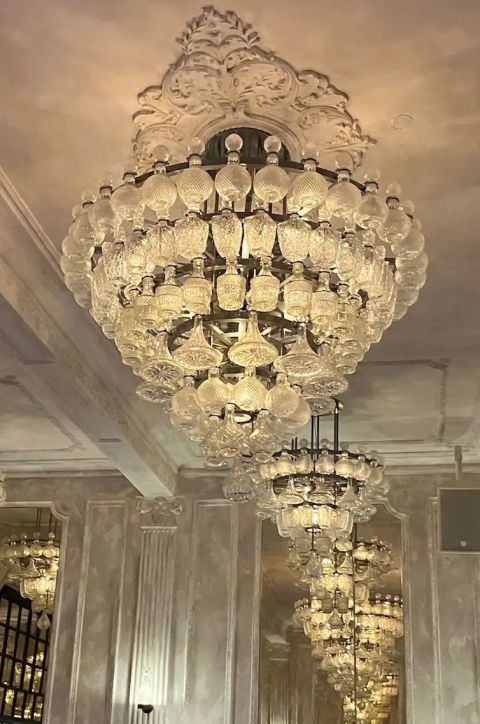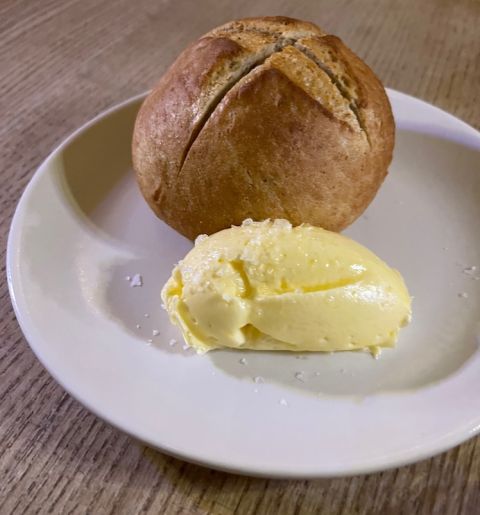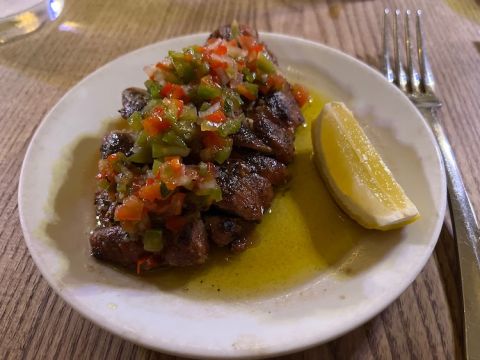London
Argentine chef Fernando Trocca is a chef who believes in the restorative power of good bread, whether this is at breakfast or dinner. Having opened his first restaurant, Mostrador, in Uruguay, he had opened several more of the same name around the world before coming to London where in 2021 he opened Sucre on Great Marlborough Street in the heart of the West End (see above).
Then a month ago he opened, as a six-month pop-up, a Mostrador on Great Eastern Street that is part of the smart, new Hart’s Hotel (no relation to the Harts of Barrafina etc, Hambleton and the hotel of the same in Nottingham), linked via the hotel reception. On any day other than the one I chose to visit, the view must be lovely. This restaurant, on the ground floor, has windows right across Great Eastern Street that wrap around it to let in max sunshine. But on the day I chose, London was hit by torrential rain that made even crossing the street a hazard.
The welcome was warm, however, and the interior, full of light wood, is comfortable and inviting. Past the takeaway counter and an expansive display of takeaway patisserie, I was seated, my wet raincoat put to one side, and shown the breakfast menu. It is at this stage that I begin to feel sorry for chefs when preparing a menu from which most customers will invariably choose their tried and tested favourite dishes. How often can a breakfast menu be surprising? Rarely, I would suggest. There was the dish of cachio e pepe eggs at Maialino in New York but perhaps the most unforgettable breakfast menu – that of Ballymaloe outside Cork, Ireland – is only as wonderful as it is because it offers everything that anybody could ever dream of ordering, all on a single sheet of paper.
And yet there was one dish that caught my eye, described as ‘fried egg muffin, avocado, bacon, aioli’ at £10, which I ordered along with a latte. I was very pleasantly surprised when I was swiftly served, on a light grey, rimmed plate, a muffin that had been split in two and the left hand half covered with a fried egg criss-crossed by three strips of bacon on aioli while the right hand half had been spread with aioli and topped with half a dozen slices of avocado, gently peppered. The combination proved fabulous, a lovely mixture. I happily paid my bill of £20 (including a too-sweet version of a morning bun) and returned gingerly to the pouring rain.
Later that week I visited Sucre. Whereas Mostrador’s interior has the advantage of an awful lot of natural light, Sucre has none. But it makes up for this with an extremely glamorous interior that seems to shout South America. There is a smart reception area and beyond this an extremely chic, and obviously busy bar area. To the right is a wine ‘cellar’ and beyond both of these is the main dining room.
It is large, like the countries of South America, with extremely high ceilings hung with a dozen imposing chandeliers that are comprised predominantly of decanters (someone must have had a lot of fun designing and making these, pictured below) so the noise here, even when full, is not that excessive.
The kitchen at the far end is staffed by half a dozen young men and a large asador, a South American grill, from which sparks emerge. To the right is a substantial collection of sacks of barbecue wood.
I am seated at one of the tables for two that run round the circumference of the restaurant and handed the single sheet of menu by a smiling young waiter, along with a leather-covered wine list and a cocktail list from which I immediately ordered a margarita on the rocks, a drink that will last me the meal. The menu is simply broken down into snacks, small and large plates – the latter two a stripling and bone-in ribeye, both served with fries, to share.
But my eye and appetite are caught by two dishes. The first is a sweetbread, salsa criolla; the second a dish described as saffron risotto, veal osso bucco, a dish brought to Argentina by its many Italian immigrants over the years. I order both and my waiter returns carrying a plate of happiness. On it sits a roll, sliced into four along the top, and next to it a mound of dark yellow butter topped with a generous sprinkling of sea salt that is to prove absolutely delicious. I eat a quarter of it immediately. The next quarter I enjoy with my first course and feel then like asking for my bill.
My first course arrives. It is a slab of sweetbread, crisp on the outside, soft in the middle, exquisitely cooked on the barbecue, but made even more appetising by its spicy topping, the sauce criolla. This Creole salsa is made of finely chopped onions, vinegar, tomatoes, garlic, peppers, olive oil, salt, pepper and coriander. But its secret remains in the hands of the person chopping, who on this occasion had it all down perfectly.
My main course was fine. The risotto a deep yellow, topped with cubes of meat and its essential sauce. I ate most of it and when my waiter enquired, my response was honest, ‘Yes, it was delicious but just a bit salty.’ Within a few minutes he returned, apologised and said that I would not be charged for this dish at all. This was an extremely generous gesture on the restaurant’s part but not what I had intended. I only believed that the kitchen ought to know. This prompted me to order a dessert, a dish described as ‘wood-fired cheesecake’ that was good, as was the accompanying salad of strawberries. I paid my reduced bill of £45 and left Sucre with a smile on my face.
This was accentuated by the restaurant’s wine list. Although I did not enjoy any of its contents on this occasion, I liked its personal approach. The wine list opens not with the normal selection of wines by the glass but rather with a particular explanation of its contents. I loved its opening sentence, ‘Our wine list is a story of immigration’. This struck a chord with me perhaps because at a recent reunion of the old team from my days at L’Escargot, I was given a wine list from 1982 that began with the heading ‘Names of the Wines’ and attempted to relate the American wines on the list, which are known predominantly by their major grape variety, to their European counterparts. Every wine list is an expression of the hard work of the restaurateur, the sommelier, or some member of the team [that was me – JR] and takes a considerable amount of time to put together. I do feel that more establishments should shout about what lies behind their wine list
Mostrador 61–67 Great Eastern Street, London EC2A 3HU; tel: +44 (0)20 3995 3622
Sucre 47b Great Marlborough Street, London W1F 7JP; tel: +44 (0)20 3988 3329
Hambleton
Aaron Patterson has been the executive chef at Hambleton Hall for more than 25 years. And although today he is not to be found every breakfast, lunch and dinner in the kitchens of this extremely well-managed and comfortable hotel overlooking Rutland Water, his influence on everything that this kitchen produces is still quite evident.
He has come to a sensible arrangement with Tim Hart, Hambleton’s founder and owner. Patterson will concentrate on four very distinct areas: he will be responsible for finding new ingredients and for maintaining the very good relations with their numerous suppliers; he will be responsible for training the kitchen staff at the Hart’s hotel in Nottingham; and he will keep an eye on the kitchen at Hambleton, although this is now formally under the control of two head chefs, Charlie Jones and James Stone.
Hambleton Hall is one of the very few country house hotels still pretty much in its original form under its original ownership, that of Tim and Stefa Hart. Little has changed in the intervening 40 years. One still needs an actual key for the bedroom, where light switches are of the up or down variety, needing no technological expertise. The gardens are still extremely attractive, even in November. There is still a portable radio in the bathroom. And there is still a freshly folded newspaper hanging in a cloth bag outside your door at 7 am. As such, this hotel is not for everybody.
But it is definitely a place for those who like to eat and drink extremely well. The two dinners we enjoyed were impressive: a colourful salad of crab with plenty of acidity as a first course and their version of a tiramisu as dessert, made even more glorious by the contents of a bottle of 1952 Blandy’s Madeira, a combination that was surpassed by a loin of venison and a dessert described as ‘a taste of Eccles’, basically a deconstructed Eccles cake without a hint of pastry. Both, however, were put into the shade by our one lunch for the 16 of us embarked on a sequel to last year’s Yquemfest: a nourishing bowl of beef and tomato consommé (perfect after a long wine tasting), an intricate terrine of beetroot (a dish that took me back to the 1980s), followed by a soufflé of unwaxed lemons with sorrel ice cream. Jones and Stone are doing an excellent job.
Their breakfast should not be overlooked either. As David Pitchford – the culinary half of the couple who have run Reads in Faversham, Kent, for as long – once told me, ‘Breakfast should always be given priority because it is invariably the last meal the customer enjoys before leaving’ (one reason why he is always to be found in their kitchen at breakfast). Hambleton’s bread basket, supplied by the Hambleton Bakery, is unmissable.
Hambleton Hall Hambleton, Oakham, Rutland LE15 8TH tel +44 (0)1572 756 991
Bologna
When one of my oldest friends emailed recently to say that he and his wife were off to famously gastronomic Bologna and where would I recommend they eat, I realised that I had never visited here. I promptly contacted our Walter Speller.
Back came three possibilities. His real passion is for Buriani in Pieve di Cento, about half an hour’s drive away. His husband Gregor’s suggestion was for Osteria Bottega on the Via Santa Caterina in Bologna (+39 05 158 5111), which Walter had never visited so he could not wholeheartedly recommend it. But he did recommend Scaccomatto on the Via Broccaindosso, which my friends immediately booked.
There apparently they ate extremely well. Alongside a photo of his smiling wife, came a long list of all that they had enjoyed: barbecued onions in a creamy sauce; peppers stuffed with salt cod; beef in anchovy sauce; chicken broth with a light pasta; and they finished with a local version of panna cotta. There, they also enjoyed meeting chef Mario Ferrara and his son.
This is a service that those at JancisRobinson.com would, I am sure, feel happy about providing for readers other than myself and my friends.


















